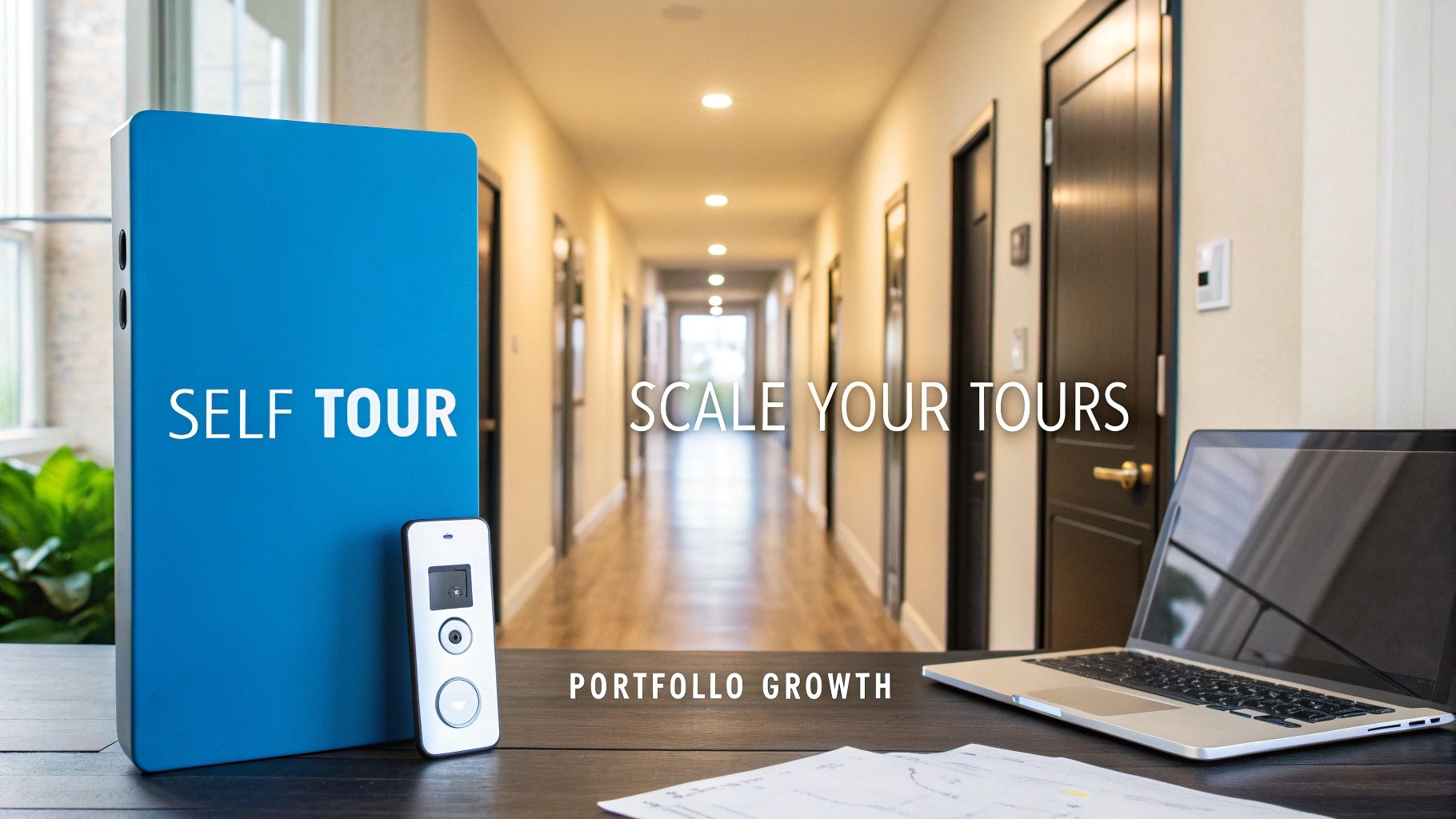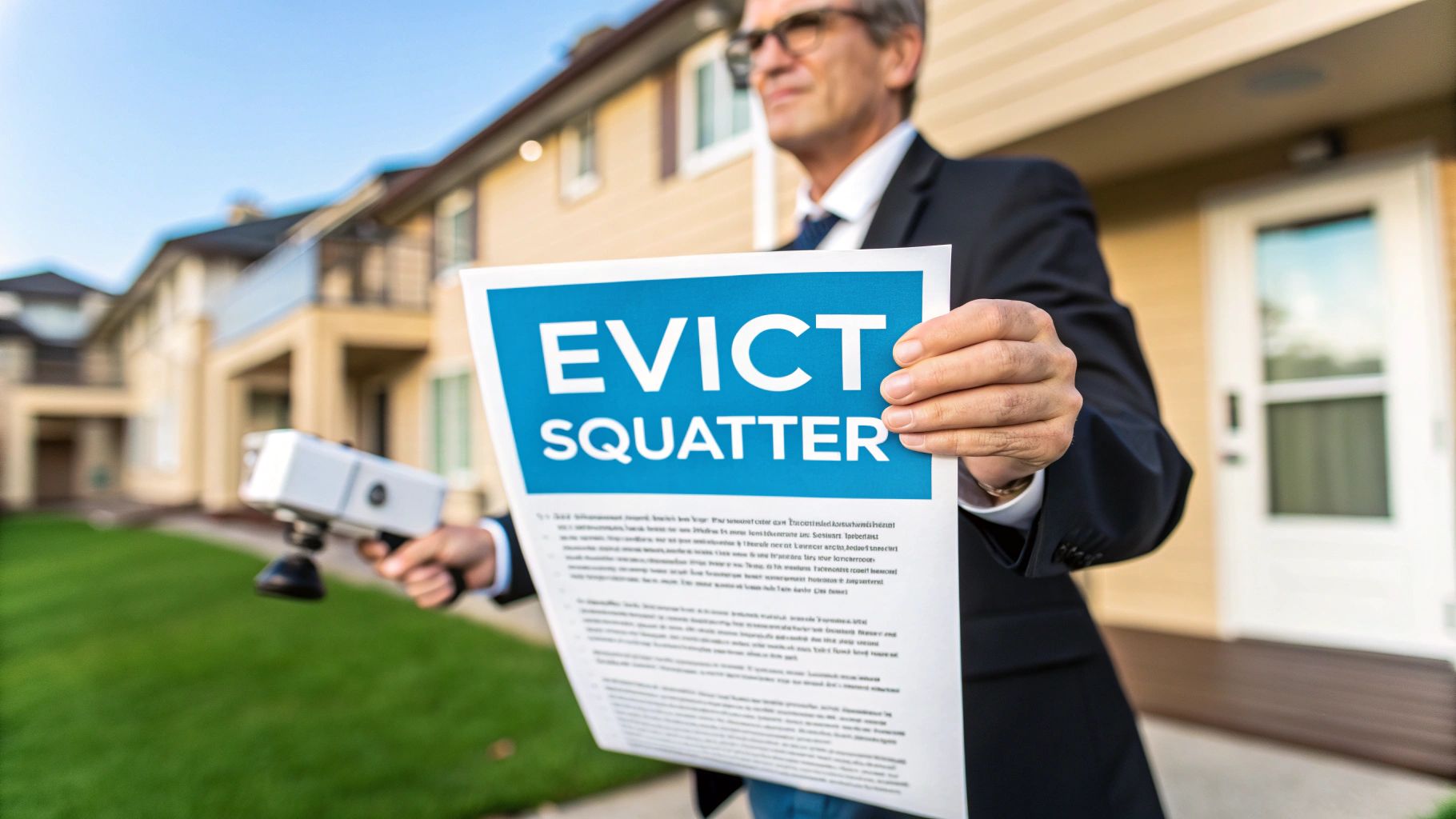Self-tour apartments are exactly what they sound like: a way for prospective tenants to view a vacant unit on their own time, without a leasing agent needing to be there. This is powered by tech like smart locks and automated scheduling systems, giving renters the on-demand access they’ve come to expect. For property managers overseeing hundreds or thousands of scattered-site units, this isn't just a nice-to-have; it’s a critical operational strategy for reducing cost per door and leasing units faster.
Why Self Tours Are Crucial for Large Portfolios
If you're overseeing a large portfolio, the agent-led tour model is an operational bottleneck. Every hour your team spends coordinating schedules, driving between properties, and walking prospects through units is an hour they aren't spending on high-impact, revenue-generating activities like closing qualified leads. This friction is a direct cause of higher Days on Market (DOM), which means significant revenue leakage across your portfolio.
Today’s renters operate on an "on-demand" schedule. They expect immediate access. If a high-intent lead has to wait 24 or 48 hours for an agent to become available, they aren't waiting. They are scheduling tours with competitors who offer that flexibility. That delay is a primary driver of lead-to-tour conversion drop-off.
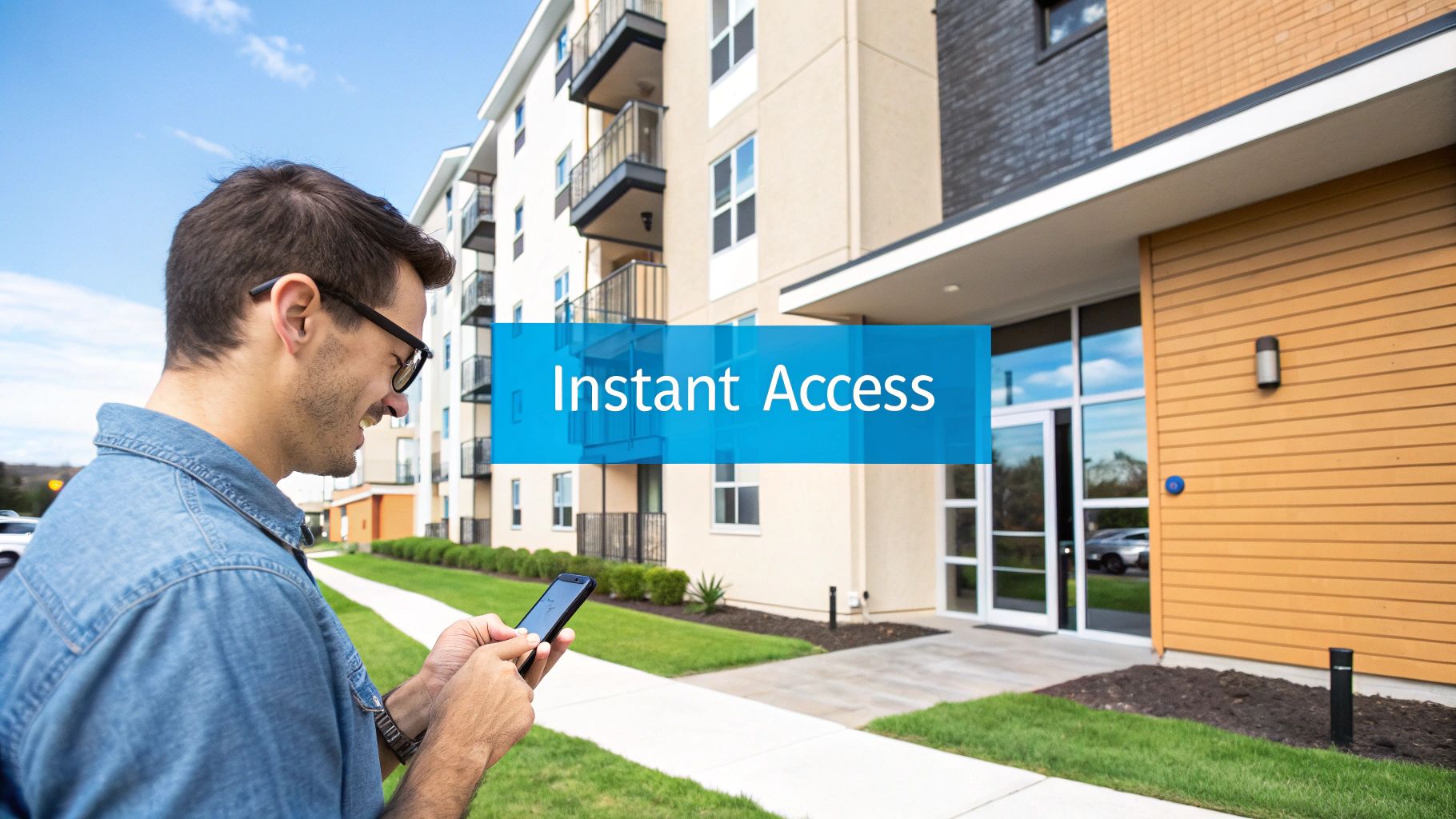
Addressing The Scalability Challenge
A well-designed self-tour system addresses the core challenges of managing a distributed portfolio. It decouples the leasing process from your team's physical location and availability, allowing you to offer a virtually unlimited number of tours across every property, 24/7. This isn't just about convenience—it's a massive strategic advantage for remote management operations.
Key operational improvements include:
- Eliminating Scheduling Friction: A prospect can find a listing, book a tour, and be inside the unit in minutes. You capture their interest at its absolute peak, maximizing lead-to-tour conversion.
- Optimizing Staff Resources: Your leasing agents are no longer just tour coordinators. Their time is reallocated to what they do best: nurturing qualified leads, processing applications, and accelerating the speed-to-lease.
- Standardizing the Tour Experience: It doesn't matter if the property is across town or in another state. Every prospect gets the same simple, high-quality access experience, ensuring brand consistency across multi-market portfolios.
The shift toward autonomous, tech-first experiences is already here. A recent Apartments.com survey found that a staggering 84% of scheduled tours came from renters who had already conducted detailed online research. This proves prospects are more than comfortable using technology to drive their apartment search. Self-touring is the next logical step in optimizing that journey.
Revenue Impact Calculation: For a 1,000-unit portfolio with an average rent of $1,800/month, every single day a unit sits vacant costs the portfolio $60,000. Reducing DOM by just five days translates to $300,000 in recovered annual revenue. Self-touring is one of the most powerful levers for achieving this.
The Financial Impact of Speed to Lease
Ultimately, the most compelling reason to implement a self-tour model is its direct impact on financial performance. The math is straightforward: faster tours lead to faster applications, which lead to faster lease signings. Accelerating the lead-to-lease cycle is the key to minimizing vacancy loss.
Implementing a self-touring system turns vacancy from a fixed cost into a manageable variable. By offering instant access, you cater directly to the most motivated renters—the ones ready to make a decision now. This not only reduces your cost per tour but also drastically cuts the time required to secure a qualified tenant, providing a direct boost to your Net Operating Income (NOI).
Self Tour Impact on Key Property Management KPIs
A self-touring system isn’t just a new technology. It’s a fundamental operational shift that allows you to scale leasing efforts efficiently, meet modern renter demands, and directly improve your portfolio's financial performance.
Building a Scalable Self Tour Technology Stack
Selecting the right technology is the foundation of a self-tour program that can scale with your portfolio. For large-scale operations, the conversation moves beyond gadgets to hard metrics—cost per door, robust security protocols, and seamless integration with your existing Property Management Software (PMS).
Your tech stack must be an enterprise-grade workhorse, capable of handling hundreds of tours a day across different markets without becoming an operational burden. The goal is to build a system that’s secure, cost-effective, and ready to scale from 100 to 10,000+ units. This means moving from one-off property solutions to a portfolio-wide infrastructure that genuinely accelerates your lead-to-lease cycle and boosts your bottom line.
Evaluating Your Access Control Options
At the core of any self-tour system is the hardware that unlocks the door. The three main options each come with their own trade-offs on cost, security, and ease of deployment across a mixed portfolio of single-family rentals and multifamily properties without on-site staff.
Smart Lockboxes: Often the entry point for property managers, these are relatively low-cost and can be installed on any door, making them ideal for retrofitting older properties or managing a scattered SFR portfolio. The drawback? They still rely on physical keys, creating a potential failure point if a key is lost or not returned.
Full Smart Lock Systems: This is the premium option. Replacing the entire deadbolt provides the highest level of security and control. Access is purely digital via unique, time-sensitive codes, eliminating physical keys and providing a complete audit trail of every entry. While the upfront cost per door is higher, the long-term operational savings and enhanced security often deliver a superior ROI, especially for newer or high-end properties.
App-Based Access and Intercoms: Systems like ButterflyMX are designed for multifamily buildings and integrate directly with building-wide access controls. A prospect receives a digital "visitor pass" on their phone, granting access to the main entrance, common areas, and the specific unit. It’s a seamless, premium experience but requires a more significant upfront investment in building infrastructure.
The right choice depends on your portfolio composition. For a portfolio of 500 scattered single-family rentals, the flexibility of smart lockboxes might be optimal. For a new 200-unit apartment community, an integrated smart lock system is the clear choice for long-term value.
Criteria for Enterprise-Grade Selection
For portfolios managing thousands of doors, the software platform powering your self tour apartments is as critical as the hardware. It is the central command center that automates scheduling, verifies prospects, and syncs with your core operational systems.
A robust software platform is non-negotiable for scaling. It must handle the heavy lifting of lead management and tour logistics automatically. For a deeper analysis, see our guide on how to choose the right self showing software, which breaks down the features that matter for large-scale operations.
When vetting platforms, focus on these key areas:
Integration Capabilities: How well does it connect with your PMS (like Yardi, RealPage, or AppFolio) and your CRM? Manual data entry is the enemy of scale. You need a system where lead data, tour schedules, and prospect feedback flow directly into your central records without manual intervention.
Security and Verification Protocols: How does the system screen prospects? Look for essential features like multi-factor ID verification, credit card validation, and the use of one-time, expiring access codes. These are not optional—they are essential for mitigating risk across a large, unattended portfolio.
Scalability and Reliability: Can the platform handle thousands of tour requests simultaneously without performance degradation? An enterprise-grade platform is built on an infrastructure that supports high volume and delivers consistent, reliable service, which is critical for protecting your brand's reputation.
Comparison of Self Tour Access Technologies
An analysis of the most common access solutions for self-touring, evaluated by criteria critical to large portfolio managers.
Building a scalable tech stack means selecting solutions that reduce operational friction and directly contribute to lowering your Days on Market. By focusing on tight integration, robust security, and proven reliability, you can build a self-touring program that not only meets modern renter demands but also becomes a powerful engine for your portfolio's performance and revenue growth.
Automating Your Lead to Tour Funnel
In today's rental market, speed is everything. A prospect who expresses interest on Monday will sign a lease with a competitor by Wednesday if they cannot see your unit immediately. The traditional process of email and phone tag to schedule a tour is a major leak in your revenue pipeline, especially for large portfolios.
The solution is a fully automated workflow that moves a lead from initial inquiry to a confirmed tour in minutes. This is about capturing prospects at their moment of peak interest and slashing your Days on Market (DOM). By removing manual delays, you prevent leads from going cold and improve your lead-to-tour conversion rate.
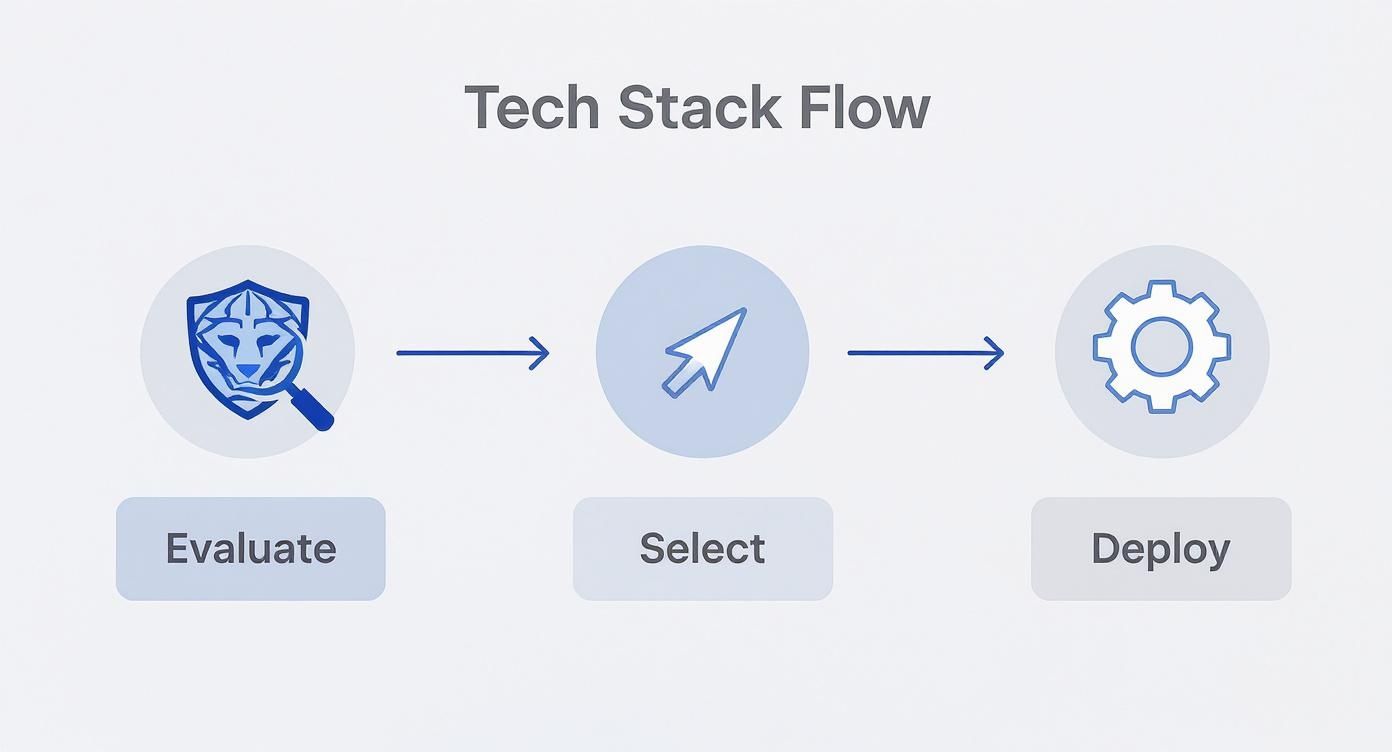
A solid automation strategy starts with evaluating your specific needs, carefully selecting integrated tools, and rolling them out with a clear, phased implementation plan.
Designing a Seamless Scheduling System
At the heart of your automated funnel is a 24/7 scheduling system that consolidates all tour requests. This system must integrate directly with your primary lead sources—your website, ILS listings (Zillow, Apartments.com), and social media—to create a single, manageable pipeline.
When a prospect clicks "Schedule a Tour," they should immediately see a calendar with real-time availability. This simple step eliminates the "we'll get back to you" lag that kills momentum and loses leases.
For this system to scale, it requires these non-negotiable features:
- Real-Time PMS Integration: The system must connect to your PMS to ensure it only shows slots for vacant, ready-to-tour units, preventing double bookings and operational errors.
- Customizable Tour Windows: You need granular control to set specific showing hours for each property or unit, accommodating cleaning schedules, local regulations, and other logistical constraints.
- Automated Buffering: The system should automatically add buffer time between tours to ensure a professional experience and prevent prospects from overlapping.
Implementing Essential Screening Protocols
Allowing prospects to tour properties unattended requires a rock-solid, automated screening process. This is your digital gatekeeper, filtering for serious, qualified renters and ensuring your leasing team's time is spent on high-intent leads. This process must happen automatically before a tour is confirmed.
The goal is not to build an impenetrable fortress but to add a layer of accountability that qualifies genuine leads and deters unserious inquiries. An automated system does this without bias, 24/7.
Your automated screening protocol should include:
- Identity Verification: The first line of defense is requiring prospects to upload a government-issued ID. Modern platforms use technology to confirm its authenticity in real-time.
- Pre-Qualification Questions: Build short, qualifying questions into the scheduling flow, such as, "Is your desired move-in date within the next 30 days?" or "Does your household income meet the 3x rent requirement?" This quickly filters out prospects who do not meet your basic criteria.
- Credit Card Authorization: Placing a small, temporary hold on a credit card is a powerful tool. It’s not a charge, but it confirms identity and adds a layer of accountability that dramatically reduces no-shows and deters bad actors.
Activating Automated Communication Triggers
Once a prospect is verified and booked, a sequence of automated messages takes over. This nurtures the lead and ensures a seamless experience—all without manual intervention from your team. This is how you guide the lead from booking through post-tour follow-up.
Integrating the right marketing automation for your leasing tech stack is a game-changer for conversion rates.
Your automated communication workflow should include these triggers:
- Instant Confirmation: Immediately upon booking, the prospect should receive an email and text confirming the tour details: date, time, address, and special instructions.
- Smart Reminders: Send automated reminders 24 hours and 1 hour before the tour. This simple step has a significant impact on reducing no-show rates.
- Post-Tour Follow-Up: Minutes after the scheduled tour ends, another message should be sent asking for feedback and—most importantly—providing a direct link to the online application.
This automated funnel transforms your leasing operation from a reactive, manual process into a proactive, efficient machine. Every lead receives an instant response, is qualified consistently, and is nurtured effectively, resulting in faster leasing and improved portfolio performance.
Nail Down Your Safety and Liability Protocols
Implementing unattended tours across a large portfolio requires a robust safety and liability framework. A well-designed self-tour program, built on technology and clear protocols, can be more secure than traditional showings by creating a digital barrier that vets prospects and establishes accountability from the start.
This is about more than just protecting property; it's about creating a professional and safe experience for qualified renters while mitigating risk across your entire portfolio.
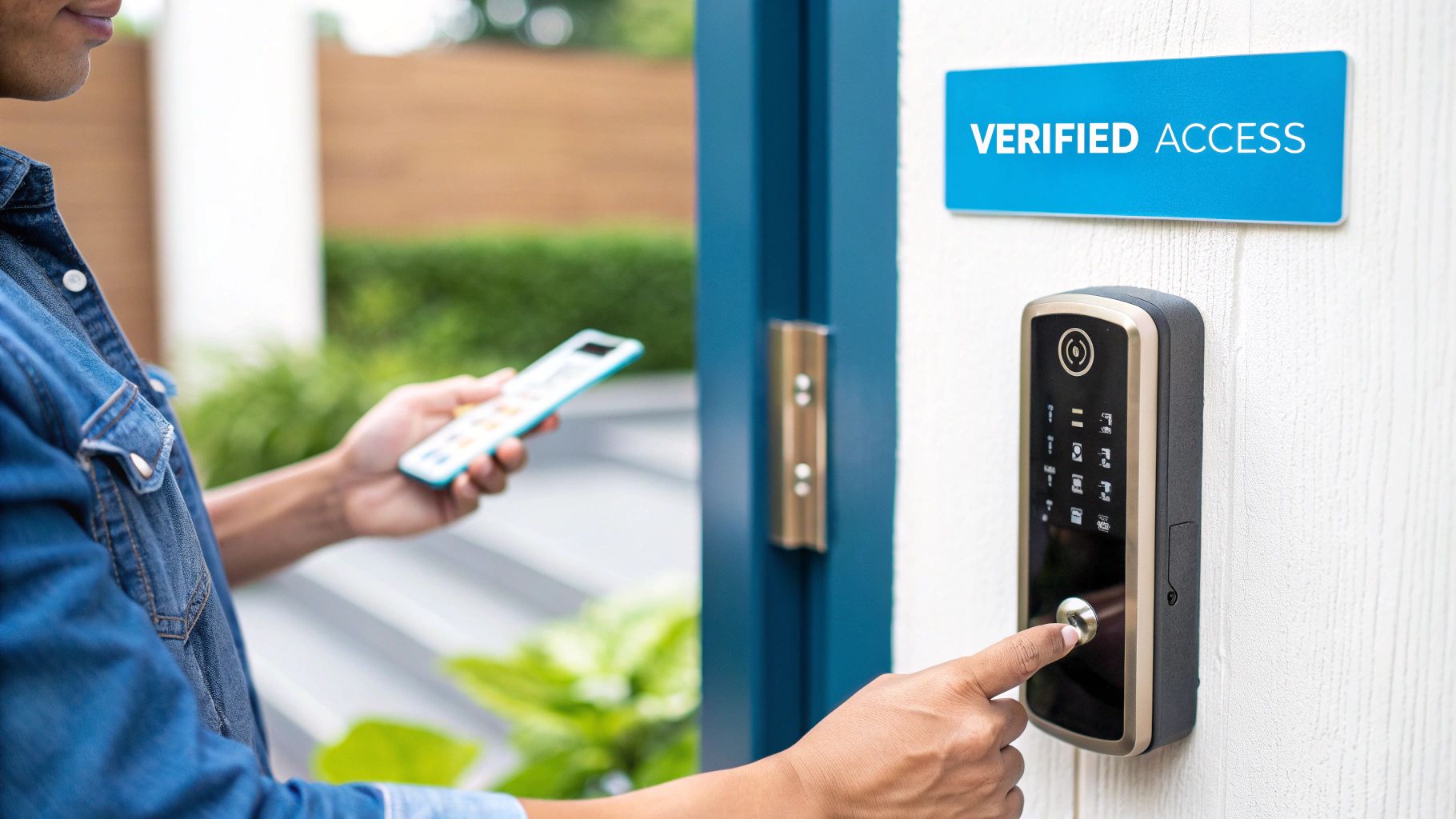
The Core of a Secure Self-Tour Program
A scalable safety protocol is built on layers of automated verification and access controls. This ensures only serious, properly identified prospects can tour your units.
First is multi-factor identity verification. This is non-negotiable. Before a tour is confirmed, the system must require the prospect to upload a clear photo of their government-issued ID, which is then validated by technology. This is often paired with a small credit card authorization hold to confirm the person's identity and deter anyone with malicious intent.
Next is dynamic access control. Static lockbox codes are a significant security risk. The enterprise standard is one-time, expiring access codes. Each verified prospect receives a unique code that only works for their specific tour window. Once that time expires, the code becomes useless. This eliminates the risk of unauthorized re-entry and creates a complete digital audit trail of who entered the property and when.
A self-touring system creates a clear digital paper trail for every single tour—from ID verification to time-stamped entry logs. This is a far more accountable and secure setup than traditional methods that often lack formal tracking.
Beef Up Your Legal and Insurance Protections
Technology must be backed by a rock-solid legal and insurance framework. This is where you establish clear terms and ensure you are covered in the event of an incident.
Before a prospect receives an access code, they must digitally agree to your non-negotiable terms and conditions. This agreement should clearly outline the rules of the tour, state their liability for any damages, and include an acknowledgment that they are entering the property at their own risk. This is a critical step in limiting your liability.
It is also essential to consult with your insurance provider. Explain your new self-touring process and confirm that your policy covers unattended showings. Many carriers view these tech-enabled security protocols favorably and may even offer better rates for self-tour apartments.
For an added layer of security, consider geofencing. This technology uses the prospect's smartphone to confirm they are physically at the property before the one-time code can be activated, preventing code sharing and ensuring the verified individual is the one opening the door.
Measuring ROI and Optimizing Performance
Launching a self-touring program is a strategic investment designed to directly boost your net operating income. For large portfolio managers, this is a financial play. It requires moving beyond anecdotal efficiencies to hard data that proves ROI.
The goal is to draw a direct line from on-demand access to a healthier bottom line. This means tracking the key performance indicators (KPIs) that matter, from the first click on a listing to a signed lease. With this data, you can quantify the value your self-tour program is delivering and make informed decisions to scale its impact.
Defining Your Core Performance Metrics
To demonstrate success, you need a dashboard that tracks the core metrics of your leasing engine.
Your must-track KPIs should include:
- Lead-to-Tour Conversion Rate: The percentage of inquiries that result in a completed tour. This is a primary indicator of your scheduling process's efficiency and ability to capture high-intent leads.
- Tour-to-Application Rate: Of the prospects who complete a self-tour, how many submit an application? This metric reveals the quality of your leads and the effectiveness of the tour experience.
- Cost Per Tour/Acquisition: Calculate the total cost of your technology and related overhead divided by the number of completed tours. For large portfolios, this figure must be significantly lower than the cost of an agent-led tour.
- Days on Market (DOM): The ultimate measure of success, tracking the time from listing to lease signing. A sustained reduction in DOM is the most powerful signal of a strong ROI.
Calculating the True ROI of Self Tours
The ROI calculation extends beyond comparing hardware costs to an agent's hourly wage. The most significant financial impact comes from recapturing revenue that would otherwise be lost to vacancy.
First, calculate your daily vacancy cost per unit: (Average Monthly Rent / 30 Days).
Now, apply this at scale.
ROI Calculation: For a 1,000-unit portfolio with an average rent of $2,000/month, the daily vacancy cost is approximately $67 per unit. If the entire portfolio is vacant for just one day, you've lost $67,000. Shaving just 5 days off your average DOM across the portfolio's annual turnover can add hundreds of thousands of dollars back to your revenue.
This is why flexible, tech-forward living solutions are growing rapidly. The global serviced apartment market growth and its drivers—a prime space for self-tour apartments—was valued at approximately $126.88 billion in 2024 and is projected to reach $420.89 billion by 2034, signaling a massive shift in renter preferences.
A Framework for Continuous Optimization
A self-tour program is not a "set it and forget it" tool. The data you collect should be used to continuously tune your strategy and optimize your operations.
Implement an ongoing optimization loop:
- Analyze Lead Sources: Dive into your analytics. Are leads from your website converting to applications at a higher rate than those from an ILS? Identify which channels deliver high-intent prospects and reallocate marketing spend accordingly.
- Optimize Post-Tour Follow-Up: A/B test your automated messages. Does a text sent 10 minutes after a tour ends convert better than an email sent an hour later? Find your winning formula to accelerate applications.
- Gather Prospect Feedback: Use simple, automated surveys to ask for feedback on the unit and the tour experience. This data is invaluable for identifying property-specific issues that you would otherwise never discover.
By treating your self-tour program as a dynamic part of your leasing machine, you ensure it continues to reduce DOM, maximize revenue, and improve your portfolio's operational efficiency.
Common Questions About Scaling Self Tours
For property management leaders, transitioning to self-guided tours is a significant operational shift that naturally raises questions about security, cost, and the prospect experience. Here are the most common concerns from portfolio managers considering the switch.
How Do You Keep a Property Secure Without an Agent?
Security is the top concern, and a tech-enabled system can be more secure than traditional methods. The process is built on a multi-layered security net.
It starts with identity verification. Before a tour is approved, a prospect must submit a valid, government-issued ID that is authenticated in real-time. This creates a digital identity for every visitor and filters out unserious inquiries.
Next is access control. A proper self-tour system generates a unique, one-time-use code for each tour. The code is only active during the scheduled time slot and expires immediately after. Many platforms add geofencing, requiring the prospect's phone to be physically at the property to activate the code, preventing it from being shared.
By combining digital ID verification with time-sensitive, location-aware access codes, you create a fully auditable trail. You know exactly who toured the property, when they entered, and when they left—a level of oversight often missing in traditional methods.
What’s the Real Upfront Cost and ROI for a Large Portfolio?
The initial investment varies based on hardware choices. A smart lockbox may cost $50-$150 per door, while a fully integrated smart lock system could be $250 or more.
However, the ROI is driven by reducing vacancy time. The most significant financial gain comes from slashing your Days on Market (DOM) and accelerating rent collection.
Consider this real-world ROI calculation:
- Average Monthly Rent: $2,000 (approx. $67/day in lost rent)
- DOM Reduction: 10 days
- Revenue Recaptured Per Turnover: $670
For a 500-unit portfolio with a 50% annual turnover (250 units), that $670 in savings per unit translates to $167,500 in recovered revenue annually. This financial return typically dwarfs the initial technology investment, often delivering a payback period of less than a year. This trend aligns with the broader flexible accommodation market, which relies heavily on self-access tech. The growth drivers of the flexible accommodation market show the global vacation rentals market was valued at USD 174.84 billion in 2024 and is projected to reach nearly USD 396.93 billion by 2032, highlighting the power of this operational shift.
Can These Systems Actually Talk to Our Current PMS?
Yes—and for any large-scale operation, integration is non-negotiable. Leading self-touring platforms are built with powerful APIs that sync seamlessly with major Property Management Software like Yardi, RealPage, and AppFolio.
This integration automates the entire leasing funnel:
- Lead information flows directly from your listings into the tour scheduler.
- Tour appointments automatically populate in your PMS calendar.
- Prospect feedback and tour completion status are logged without manual data entry.
Without deep integration, you are simply trading one manual task for another. The goal is to eliminate administrative drag and create a single source of truth for your entire leasing operation.
What if a Prospect Has a Question or Hits a Snag During a Tour?
Modern platforms are designed to provide instant support without requiring on-site staff.
The best self-touring software includes built-in, on-demand communication channels, such as an in-app chat or a dedicated support number that prospects can call or text for immediate assistance with a lock or a question about the property.
Furthermore, automated follow-up is a key component. The moment a tour ends, the system triggers a text and email to the prospect. This message thanks them for visiting, provides a direct link to the online application, and asks for immediate feedback. This instant touchpoint is highly effective at converting a warm lead into a signed lease while the experience is still top-of-mind.
Ready to see how much you can shrink your Days on Market and cut operational drag? Showdigs offers an AI-powered leasing automation platform built specifically for large, distributed portfolios. Schedule a demo today and let us show you how to transform your leasing operations.




